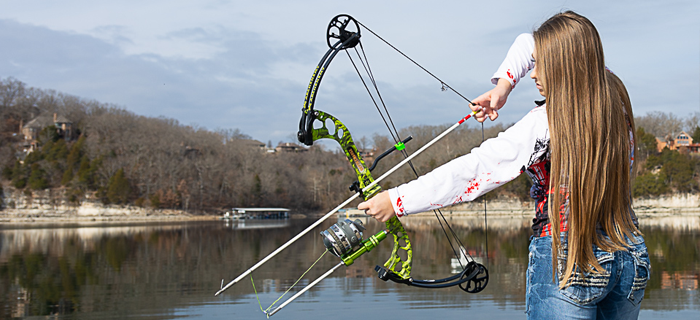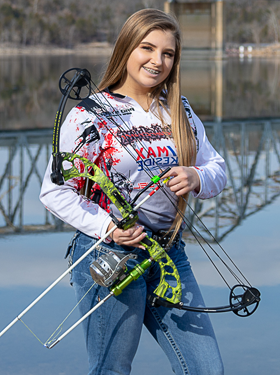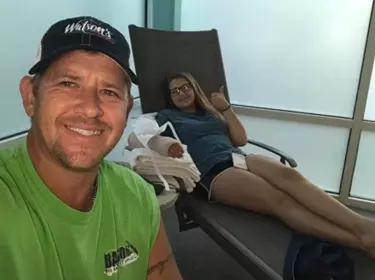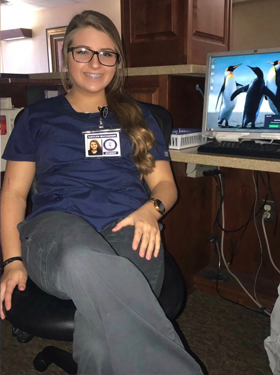- Home
- Patient Stories
- Kaitlyn Buchanan – Peripheral Nerve Entrapment
Kaitlyn Buchanan – Peripheral Nerve Entrapment

Camping with family at the age of ten, Kaitlyn Buchanan, had a nightmare and fell out of a top bunk. She was rushed to the Children’s Hospital in Denver where it was determined that she had fractured her right arm just above the elbow and required immediate surgical treatment. Once back at home in Shell Knob, Missouri, she was referred to a specialist with Washington University Orthopedics at Shriner’s Hospital for Children — St. Louis for her follow-up visits.
Kaitlyn recalls having residual numbness in her forearm and despite working with a physical therapist, she was not able to bend her elbow enough to allow her to touch her right hand to her right shoulder. Even with restricted movement, Kaitlyn did not slow down. Her father, Justin Buchanan reflects, “She just adjusted. She’s right handed but she figured out how to fix her hair and put her make up on by herself. She’d bring her face to her hand and figured out a way to put her hair in a ponytail. ”

When Kaitlyn was 13 years old she was introduced to bow fishing, a sportwhere specialized bows and arrows are used to catch fish. Her dad is a professional bow fisherman and Kaitlyn says it all started with a bet, “He bet I couldn’t shoot straighter than him, and I out shot him.” After that win, she immediately fell in love with the sport. But over the next few months, Kaitlyn’s dad noticed in addition to the increasing fatigue in her right arm that she was losing more and more strength. “I had to keep cranking down the resistance in her bow and she was favoring her right arm more and more.” Her symptoms progressed to the point that Kaitlyn was not able to lift a gallon of milk.
Regardless, she joined the softball team her freshman year. She played left field and second base and still had one of strongest throwing arms. At the beginning of her sophomore year, she started noticing her right arm would be tired and achy after a game and began icing and resting it more. Eventually, after two or three throws she was having to sit out and ice her arm.
Kaitlyn and her family consulted an orthopedic specialist in her area and a grip strength test showed the vast difference between her left and right arm. With her left arm she was able to grip at 60 pounds and with her right she was only at nine pounds. The reason for the discrepancy was undetermined and as a result, specific treatment could not be recommended.
During Kaitlyn’s sophomore year of high school, she experienced extreme muscle fatigue and began having arm and muscle spasms that were out of her control. Kaitlyn says, “It was a dull pain along with a feeling of little pins and needles.” Kaitlyn ended up removing herself from playing softball and became the team’s manager and even writing became painful. The spasms evolved into more like an arm seizure and could last up to two hours. “I had no idea what triggered them and once they started there was nothing that helped. We would ice it and then try a heating pad.” Justin, Kaitlyn’s dad, remembers, “Her pain and arm spasms would get so bad that it would cause her to have a panic attack and she ended up in the emergency room a few times. As her father, it was so hard because all I could do was sit and hold her while she cried.” Kaitlyn recalls times where she and her dad would sit and try several things to see what would trigger the spasms. She said the spasms began happening more frequently and even once she was driving and had to pull over and wait for the spasm to pass. Kaitlyn’s trips to the emergency room increased in frequency because of the severity of the pain. She was usually given morphine through an IV to ease the pain and x-rays to make sure nothing was broken. “It was frustrating. There were several dead ends and I would leave each ER visit in tears,” says Kaitlyn.
Kaitlyn and her dad decided it was time to see another orthopedic specialist and drove an hour and half away to Springfield, MO. Due to the complexity of her condition, the specialist referred Kaitlyn to Heidi Prather, DO, a physical medicine and rehabilitation specialist at Washington University Orthopedics.
Kaitlyn says that she was immediately impressed with Dr. Prather. “At my very first visit with her, she began pushing on different areas of my arm and then stopped and said she was so sorry. I was confused and asked why she was sorry.” Dr. Prather said, “I triggered it.” Within seconds Kaitlyn’s arm started to involuntarily contract in various muscles across her shoulder and elbow. She says the relief of just finding a trigger was overwhelming but Dr. Prather’s compassion was amazing. “She was so determined and loving when she said we would find out what we can do to fix this.”
“From the diagnostic perspective,” Dr. Prather relates, “I was fortunate to witness an episode in the office. It was clear that she had developed a movement disorder as a result of a previous injury that had continued to be symptomatic. A peripheral nerve entrapment can be the nidus that triggers a movement disorder.” Kaitlyn underwent a trial of different treatments including medications targeting nerve pain. Bracing and other medications were prescribed with the intent of stopping an episode once it started. These treatments helped the intensity of the episodes but the frequency and functional limitations did not change. An initial nerve test did not reveal the problem. “Because Kaitlyn’s symptoms had responded, in part, to treatment, I wanted her to pursue a consultation with the members of the Multidisciplinary Complex Nerve Clinic to see if they agreed with the diagnostic pathway we had taken and get their expert collaborative advice," says Dr. Prather.
 Christopher Dy, MD, MPH, FACS, and David Brogan, MD, MSc, both hand and microsurgeons, along with Dale Colorado, DO, MPH, a physiatrist, who all specialize in nerve injuries at Washington University Orthopedics at Barnes-Jewish Hospital were consulted. Dr. Brogan reflects, “Once Dr. Dy and I saw her, we agreed with Dr. Prather’s assessment and thought that a small nerve branch had been trapped in scar tissue from her prior injury.” In collaboration, Dr. Colorado repeated part of the nerve test which led to an Ultrasound-guided diagnostic peripheral nerve block. The block confirmed the diagnosis.
Christopher Dy, MD, MPH, FACS, and David Brogan, MD, MSc, both hand and microsurgeons, along with Dale Colorado, DO, MPH, a physiatrist, who all specialize in nerve injuries at Washington University Orthopedics at Barnes-Jewish Hospital were consulted. Dr. Brogan reflects, “Once Dr. Dy and I saw her, we agreed with Dr. Prather’s assessment and thought that a small nerve branch had been trapped in scar tissue from her prior injury.” In collaboration, Dr. Colorado repeated part of the nerve test which led to an Ultrasound-guided diagnostic peripheral nerve block. The block confirmed the diagnosis.
“Before I even left the appointment with Dr. Brogan, I had no doubt I wanted the surgery. Dad and I were both crying because we had finally found the answer and a treatment.”
Dr. Brogan says, “At the time of surgery, Dr. Dy and I found the injured nerve entrapped in scar tissue and transferred it to another spot in the arm that would be less likely to cause her pain. Post-operatively, Kaitlyn worked hard to regain her strength and function. I think that her story is a great example of the benefits of having a multi-disciplinary team to address these complex and challenging problems.”

“The assessment from Dr. Prather was spot-on — the irritability of her nerve was apparent from the clinical examination. It was clear that this pain was limiting her activities and affecting her quality of life. The diagnostic injection performed by Dr. Colorado was incredibly helpful in allowing us, the patient, and her family to gather a sense of how the nerve surgery would help her. Like it has with many other patients, this “test run” was a success, providing us with valuable prognostic information and the patient with the confidence to move forward with the nerve surgery,” remarks Dr. Dy.
Kaitlyn is now a year post surgery and has regained most of her strength and has a full range of motion of her elbow. This summer she is competing in a bow fishing tournament on live television which has been a goal ever since she started bow fishing four years ago. Additionally, as a junior in high school she had completed her certification and worked as a Certified Nurses’ Assistant at a nursing home. Going into her senior year, she will be completing her EMT certification in anticipation of applying to nursing schools. Kaitlyn states, “This surgery helped me to pursue my passion which is bow fishing, and a career in nursing and I hope for one day to be a traveling trauma nurse.”
Dr. Prather has retired from Washington University Orthopedics. To learn more about our physician medicine and rehabilitation specialists, please call (314) 514-3500.
More Info: